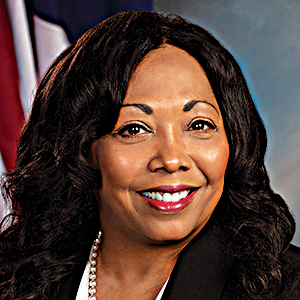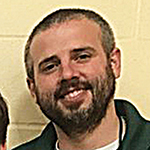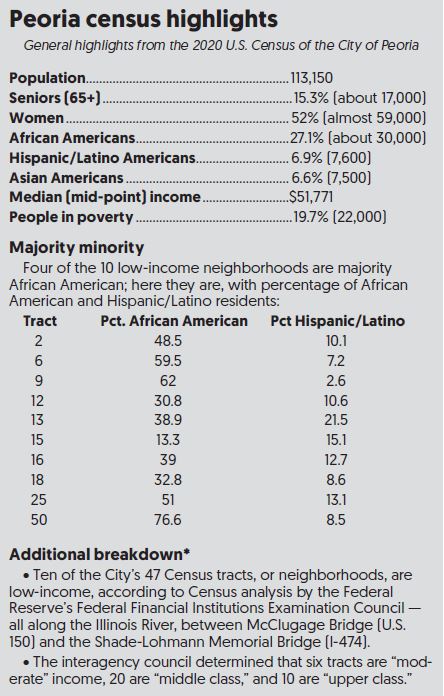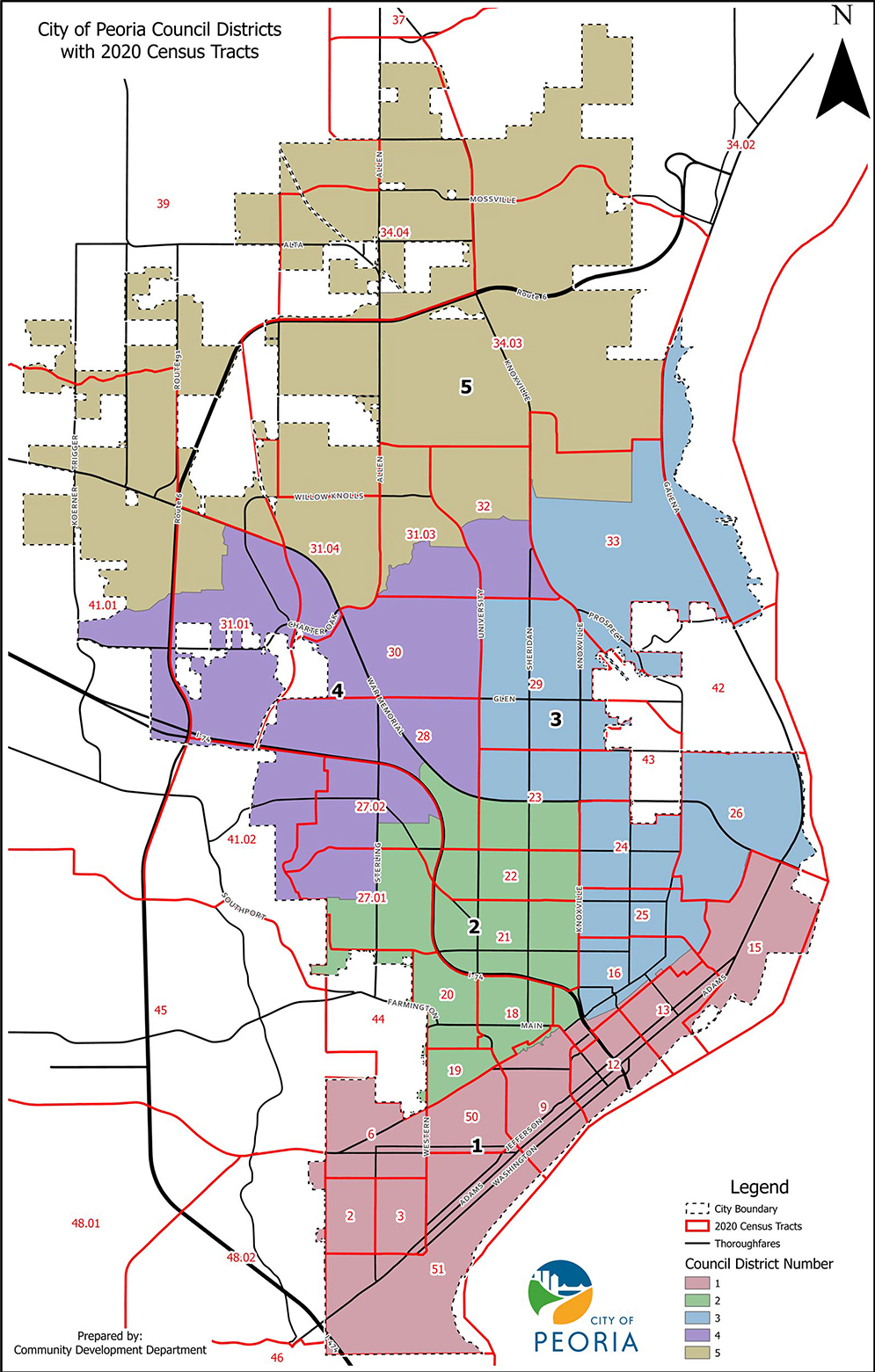The 2020 Census updated data about populations, and people may wonder what happens next. A definite result is changing local voting districts at all levels, though specifics remain unclear. A possible result is revising plans for public and private services and investments, Peoria lost population, down 1.6% from 2010, but less than projected.

Mayor Rita Ali
“I have several impressions, like we’re more racially and ethnically diverse, with a 54% White population. We have a growing Asian population, especially close to the Dunlap border.”
Others are reserving judgment on the numbers — and their significance.
“I don’t know if it matters,” said Peoria attorney and long-time community activist Don Jackson. “I’m not sure how districts will be sliced. But I suspect [South side zip code] 61605 will continue to be ignored by city government.”

Joe Dulin
Within city government, staffers such as Director of Community Development Joe Dulin agree with Ali that retaining residents was good news.
“People are moving south to warmer temperatures,” Dulin said. But “population loss was less than expected. That’s a positive.”
Ali elaborated on population findings.
“We also saw a shift — people moving within the city, moving farther north,” Ali said.
Some “migration” from the South side was due to blight, but also other reasons, she said.
“A lack of affordable housing is another factor,” the Mayor said. “We have to have housing to attract business. People want gas stations, grocery stores, and pharmacies in their neighborhood.
“So [in redistricting] we’re going to have to make some proportional adjustments” the Mayor continued. “District 1 is down 3,938; District 2 down 1,555; District 3 down 1,115. Districts 4 and 5 had increases” in population.
That means the City must change district boundaries to make them close to equal, about 22,630 people each.
Generally, redistricting is how congressional, state, county and municipal legislative districts are redrawn. In federal, state and county redistricting, partisanship often dominates. Routine political gerrymandering isn’t unconstitutional, a federal court ruled last month, but this month, New York University’s Brennan Center for Justice revealed evidence that Trump Administration officials not only abruptly ended the nationwide headcount early, but sought to improperly interfere throughout the Census.
However, many municipal governments are nonpartisan.
Peoria’s nonpartisan structure will mostly remove politics, Ali said. “We’ll avoid that as much as possible,” she said. “We’ll also get feedback from the public.”
The City held one open session Jan. 18 and has scheduled additional meetings for Feb. 1 and 15, and March 1, 15 and 29, all at 6 p.m. (Visit peoriagov.org/redistricting for details on attending virtually or offering comments; if Internet access is limited, people may provide written comments and get relevant maps at the City Clerk’s office, #401 in City Hall.)
Peoria’s redistricting “based on the Census” was approved on Oct. 12 and will happen through a committee made up of District and At-Large Council Members and chaired by Ali, who said she hopes the process will be completed by March.
“The process won’t exclusively rely on numbers,” she added. “We’ll take into account ‘Communities of Interest’ guidelines.”
Community of Interest can mean race, class, shared ancestry, language, history and, arguably, age, gender or faith.
“The term ‘Community of Interest’ did not really appear in electoral law until 1995 when the Supreme Court struck down Georgia’s redistricting plan (Miller v. Johnson),” Peoria Interim Corporation Counsel Chrissie Kapustka said. “While about half the states have a constitutional provision or statute that helps provide some clarity on the subject, Illinois is not one of them. So, we look at the three major Supreme Court cases that have dealt with this in redistricting (Miller v. Johnson, Bush v. Vera and League of United Latin Citizens v. Perry). Those cases generally define the elements of ‘Community of Interest’ as socioeconomic status, race, education, employment, health, urban character, common media and major transportation lines. Collectively, these elements help support keeping existing political subdivisions intact.”
That’s not simple.
Illinois is more diverse, too, with more Hispanics and fewer African Americans. The number of Hispanics is up 15.3% since 2010; Census respondents identifying as Black alone were 3.1% fewer than 2010. Like Peoria, the state also lost population since 2010, but less than forecast (about 18,000 residents, less than 1%). Statewide, there have been disputes over legislative districts and ward maps. Asian, Latino and Black interest groups in Chicago have haggled over proposals; in December a three-judge panel ruled against a lawsuit filed by the Mexican American Legal Defense & Educational Fund and the NAACP for unfairly splitting East St. Louis communities into separate blocs.
“We want to address the increasing Hispanic population,” said Peoria’s Dulin. “Multiple [City] departments, the Greater Peoria Economic Development Council and the school district all will be involved to attract residents and businesses in the next 10 years.
“We’re working on revitalization efforts like down-payment assistance, housing rehabilitation [programs] and affordable housing opportunities.”
In the heart of the North side along the river, the 61603 zip code, an advocate said that would be a start.
Peoria’s Hispanic population “is definitely growing,” said Catalina Zavala, director of La Familia, the Latino outreach program at Friendship House. “I’ve lived in Peoria for more than 45 years, and then, there were just six or eight families. It used to be mostly on the near north side; now we’re all over.”
They’re virtually ignored, she said. “The City needs to pay more attention and offer more services, whether it’s businesses or English as a Second Language classes or just information programs,” she continued. “Our biggest questions now are about COVID – ‘Where do I go?’ ‘What do I do?’ and so on. It’s important to keep families together.
“And there are a lot of Mexican restaurants, but neighborhoods need other businesses,” she added. “Kroger closed on Wisconsin Avenue, and a convenience store on Jefferson. We need stores for everybody, not just Mexican restaurants.
“And housing is not decent.”
At his downtown office, Jackson agreed and notes that, city-wide, the issue of housing needs context.
“The problem isn’t ‘affordable’ housing,” Jackson said. “There’s affordable housing; there’s just not a lot of good housing,” he said. “Dilapidated buildings still need to be torn down. Boarded-up houses still need to be addressed. If those eyesores were in the 61615 zip code, they would have been torn down a long time ago. North of I-74 received a lot of renovation in the last 30 or 40 years [but] not south of 74.
“The city has to give more attention to these neighborhoods,” Jackson said. “It will be ignored without pressure by council members, Mayor Ali, and ordinary citizens. There are things they could do. Doing nothing is not an option.”



Recent Comments